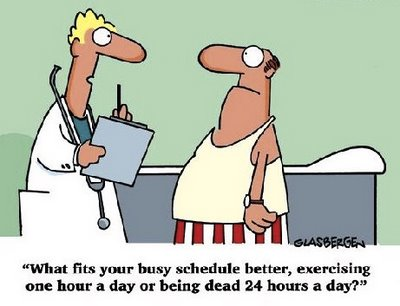
How long is too long to stop physical activity before we experience set-backs and experience health issues? Fourteen days, yes fourteen days of physical inactivity can raise the risk of chronic disease, including type 2 diabetes and heart disease. Not only that, but all the progress we may have seen with exercise ranging from weight loss, increased muscle tone, and increased energy also declines after fourteen days. In a study of young, healthy adults, researchers found that switching from moderate/vigorous activity to a sedentary lifestyle for just 14 days let to metabolic changes that can lead to premature aging and death. Everyone can appreciate that bad habits are hard to break and the longer you practice that bad habit the harder to overcome.
Current guidelines, for adults between the ages of 18 and 64, recommend 75 minutes of vigorous activity weekly. That is only 10 minutes of vigorous heart pumping exercise! The Center of Disease Control and Prevention (CDC) reports that fewer than 50% of adults meet that exercise recommendation. It may be shocking, but think of a typical American’s routine. A person gets up, gets ready for the day, sits at a desk, makes supper, watches TV, and then goes to bed. There isn’t much activity in an average American’s day except minimal walking between daily activities. This lack of physical activity throughout the day is the leading cause of obesity, which then increases our risk of type 2 diabetes, heart disease, and some forms of cancer. Bones and muscle health also are affected.
The participants of the study were active males with an average age of 25. They were reduced from 10,000 steps daily to 1,500 steps over a 14 day period. They were all required to keep a food journal to make sure health changes were related to inactivity and not dietary changes. The study concluded that reduced activity led to loss of muscle mass and increased body fat. It was noted that the majority of the body fat settled centrally in the midsection, which is a risk factor for chronic disease. The study emphasized the importance of remaining physical active and confirmed the consequences of living a continuous sedentary lifestyle.
Set a goal for yourself and take action! Make an achievable goal and begin. Start by using the stairs at work, parking your car further away from the entrance, schedule activity breaks to insure that you are introducing some form of activity throughout the day. If you find it is hard to get started, we have an option for you at Venture Fitness. All you need to do is commit to a time, show up, and we take care of the rest. Venture Fitness has various membership options, works with all levels of fitness, and the best part is it is a small group environment where you feel supported, it’s fun, and exercises are modified for you. Goals and weekly check-ins will make sure progress is being made. There are not many things in life where we our return on our investment is better health, more energy, and improved strength.
I found the hardest part was getting started, getting out of my own way, and asking for help. (I am terrible at the last part). I made the commitment, scheduled the time on my calendar like a meeting, and then I let Jason take the lead. Each member of the Venture team is here to help you move better, feel better, and be a better you! You owe it to yourself.
–Melanie Dockter DC CACCP
References:
- https://health.gov/our-work/food-nutrition/2015-2020-dietary-guidelines/guidelines/appendix-1/
- https://www.cdc.gov/nchs/fastats/exercise.htm
- https://www.medicalnewstoday.com/articles/323446#takeaway



